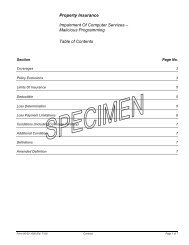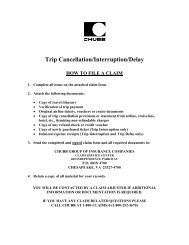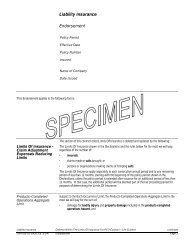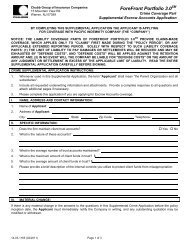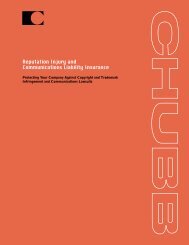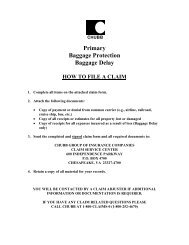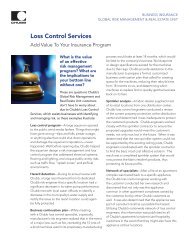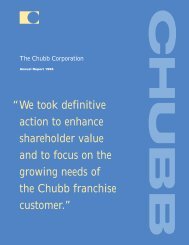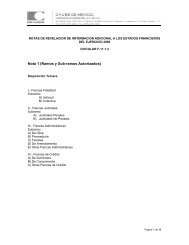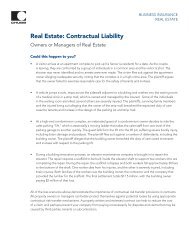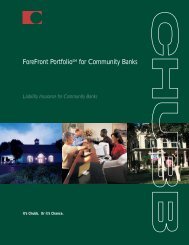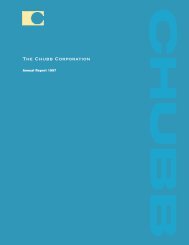Annual Report 2001 - Chubb Group of Insurance Companies
Annual Report 2001 - Chubb Group of Insurance Companies
Annual Report 2001 - Chubb Group of Insurance Companies
You also want an ePaper? Increase the reach of your titles
YUMPU automatically turns print PDFs into web optimized ePapers that Google loves.
the wake <strong>of</strong> heavy insurance industry losses, many Underwriting results were unproÑtable in <strong>2001</strong> due<br />
insurance companies have sought substantial price primarily to the Enron-related surety bond losses<br />
increases, raised deductibles, reduced coverage limits or described below, compared with near breakeven results<br />
declined outright to renew coverage. In this environ- in 2000 and unproÑtable results in 1999. The combined<br />
ment, we are seeing more opportunities to write new, loss and expense ratio, the common measure <strong>of</strong> underhigh<br />
quality accounts and we are retaining more <strong>of</strong> our writing proÑtability, was 103.9% in <strong>2001</strong> compared with<br />
business. We are getting substantial rate increases on 100.4% in 2000 and 102.8% in 1999.<br />
business we write, <strong>of</strong>ten with more restrictive policy<br />
terms and conditions. We expect that this trend will The surety losses arising from the Enron bankruptcy<br />
continue during 2002.<br />
relate to bonds issued to various obligees in connection<br />
with Enron commitments. We recognized our maximum<br />
At the same time, as a result <strong>of</strong> the substantial losses surety exposure <strong>of</strong> $220 million, net <strong>of</strong> reinsurance, in<br />
incurred by reinsurers, the cost <strong>of</strong> reinsurance in the the fourth quarter <strong>of</strong> <strong>2001</strong>. However, certain <strong>of</strong> these<br />
marketplace is increasing signiÑcantly and reinsurance bonds are the subject <strong>of</strong> litigation. Management believes<br />
capacity for certain coverages, such as terrorism, is there are reasonable grounds for challenging the validity<br />
limited. We are operating under the assumption that our <strong>of</strong> our obligations under the bonds that are the subject<br />
reinsurers will not cover most forms <strong>of</strong> terrorism. The <strong>of</strong> the litigation and intends to pursue the litigation<br />
insurance industry has asked for a government backstop vigorously. If we are successful in the litigation, any<br />
for any future terrorist attacks. However, Congress has favorable development would be reÖected in future<br />
not enacted a legislative solution to terrorism related operating results.<br />
losses.<br />
Excluding the eÅect <strong>of</strong> the Enron surety losses, the<br />
We expect that reinsurers will restructure our property combined loss and expense ratio was 100.5% in <strong>2001</strong>,<br />
per risk reinsurance to limit the amount <strong>of</strong> catastrophe similar to the 100.4% in the prior year.<br />
risk covered by these treaties. Also, in many cases, we<br />
will have to retain a larger share <strong>of</strong> a loss before<br />
The loss ratio, excluding the eÅect <strong>of</strong> the Enron surety<br />
property per risk reinsurance applies. We may not<br />
losses, was 67.7% in <strong>2001</strong> compared with 67.5% in 2000<br />
renew certain reinsurance programs because the terms<br />
and 70.3% in 1999. Catastrophe losses other than those<br />
being oÅered are too restrictive or because the programs<br />
related to the September 11 attack were $114 million in<br />
have become prohibitively expensive. In fact, eÅective in<br />
<strong>2001</strong> which represented 1.7 percentage points <strong>of</strong> the<br />
January 2002, we did not renew a casualty catastrophe<br />
loss ratio compared with $72 million or 1.2 percentage<br />
program that had substantially reduced our net workers'<br />
points in 2000 and $225 million or 4.0 percentage<br />
compensation losses from the September 11 attack. Our<br />
points in 1999. Catastrophe losses aÅecting results each<br />
current property reinsurance program expires in April<br />
year resulted primarily from weather-related events in<br />
2002. The potential increase in our net risk concentrathe<br />
United States, including in particular Tropical Storm<br />
tions from a catastrophic event that would result from<br />
Allison in the second quarter <strong>of</strong> <strong>2001</strong> and Hurricane<br />
changes to our reinsurance arrangements may be oÅset<br />
Floyd in the third quarter <strong>of</strong> 1999. Other than<br />
to some degree by changes to our gross risk proÑle. In<br />
reinsurance recoveries related to the September 11<br />
particular, we are making a concerted eÅort to reduce<br />
attack, we did not have any recoveries from our<br />
terrorism risk aggregations. A shortage <strong>of</strong> reinsurance<br />
catastrophe reinsurance program during the three year<br />
capacity could constrain our ability to respond to<br />
period since there were no other individual catastrophes<br />
business opportunities and could make our future<br />
for which our losses exceeded the initial retention.<br />
operating results more volatile.<br />
Currently, our initial retention level for each catastrophic<br />
event is approximately $100 million in the<br />
27



